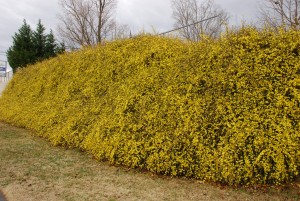Is the worst of winter behind us? Winter jasmine (Jasminum nudiflorum) is often confused with forsythia shrubs which bloom 3-4 weeks later in the spring. This hardy winter blooming vine from China frequently blooms in late February and March when daytime temperatures climb into the mid-50s for a week or more. Evening chilling temps down into the low 20’s don’t seem to injure the flowers.
This vine thrives in many parts of the mid-Atlantic and southeastern U.S. (USDA hardiness zones 6 -8) in full sun to partial shade. Its dark green tri-foliate leaves are semi-evergreen in zone 6. New foliage emerges in April after flowering has ended.
Hundreds of bright yellow 1 ½ inch tubular flowers are lightly fragrant, originating along a thick network of green stems. Winter jasmine is a very aggressive grower and is often utilized for soil retention on steep banks or to cover over an unsightly retaining wall or fence. Some gardeners grow it as a low 3-4 foot tall shrubby mound, 4-5-6 feet wide.
Winter jasmine grows in almost any soil, and demonstrates good drought tolerance once established after two years. Every 3 or 4 years rejuvenate winter jasmine by cutting back vines severely immediately after flowering.
Prune as needed in early spring just after flowering has finished. If planting starts to look scraggly, cut back hard to 12-18 inches and feed generously with 10-10-10 or equivalent fertilizer.


 Posted in
Posted in 

Hi, the photo of the retaining wall of jasmine looks impressive indeed, we grow winter jasmine over here in southern england where it stands our winters no problem but they need the rejuvenation pruning you mention to keep the flowers coming…
this vine looks a lot like forsythia is it related?
Forsythia (shrub) blooms a month later (late March-early April in northeast TN). There are several forms of forsythia, not so for winter jessamine which is more like a ground cover and is more vine like…Hugh